Asus M3N78-AM User Manual

M3N78-AM
Motherboard

E4421
Second Edition V2
January 2009
Copyright © 2009 ASUSTeK Computer Inc. All Rights Reserved.
No part of this manual, including the products and software described in it, may be reproduced, transmitted, transcribed, stored in a retrieval system, or translated into any language in any form or by any means, except documentation kept by the purchaser for backup purposes, without the express written permission of ASUSTeK Computer Inc. (“ASUS”).
Product warranty or service will not be extended if: (1) the product is repaired, modified or altered, unless such repair, modification of alteration is authorized in writing byASUS; or (2) the serial number of the product is defaced or missing.
ASUS PROVIDES THIS MANUAL “AS IS” WITHOUT WARRANTY OF ANY KIND, EITHER EXPRESS OR IMPLIED, INCLUDING BUT NOT LIMITED TO THE IMPLIED WARRANTIES OR CONDITIONS OF MERCHANTABILITY OR FITNESS FOR A PARTICULAR PURPOSE. IN NO EVENT SHALL ASUS, ITS DIRECTORS, OFFICERS, EMPLOYEES OR AGENTS BE LIABLE FOR ANY INDIRECT, SPECIAL, INCIDENTAL, OR CONSEQUENTIAL DAMAGES (INCLUDING DAMAGES FOR LOSS OF PROFITS, LOSS OF BUSINESS, LOSS OF USE OR DATA, INTERRUPTION OF BUSINESS AND THE LIKE), EVEN IF ASUS HAS BEEN ADVISED OF THE POSSIBILITY OF SUCH DAMAGES ARISING FROM ANY DEFECT OR ERROR IN THIS MANUAL OR PRODUCT.
SPECIFICATIONS AND INFORMATION CONTAINED IN THIS MANUAL ARE FURNISHED FOR INFORMATIONAL USE ONLY, AND ARE SUBJECT TO CHANGE AT ANY TIME WITHOUT NOTICE, AND SHOULD NOT BE CONSTRUED AS A COMMITMENT BY ASUS. ASUS ASSUMES NO RESPONSIBILITY OR LIABILITY FOR ANY ERRORS OR INACCURACIES THAT MAY APPEAR IN THIS MANUAL, INCLUDING THE PRODUCTS AND SOFTWARE DESCRIBED IN IT.
Products and corporate names appearing in this manual may or may not be registered trademarks or copyrights of their respective companies, and are used only for identification or explanation and to the owners’ benefit, without intent to infringe.
ii

Contents
Notices......................................................................................................... |
vi |
Safety information...................................................................................... |
vii |
About this guide......................................................................................... |
vii |
M3N78-AM specifications summary.......................................................... |
ix |
Chapter 1: Product introduction
1.1 |
Welcome!....................................................................................... |
1-1 |
|
1.2 |
Package contents......................................................................... |
1-1 |
|
1.3 |
Special features............................................................................ |
1-1 |
|
|
1.3.1 |
Product highlights............................................................ |
1-1 |
|
1.3.2 |
InnovativeASUS features................................................ |
1-3 |
1.4 |
Before you proceed...................................................................... |
1-5 |
|
|
Onboard LED.................................................................................. |
1-5 |
|
1.5 |
Motherboard overview................................................................. |
1-6 |
|
|
1.5.1 |
Placement direction......................................................... |
1-6 |
|
1.5.2 |
Screw holes..................................................................... |
1-6 |
|
1.5.3 |
Motherboard layout.......................................................... |
1-7 |
|
1.5.4 |
Layout contents............................................................... |
1-7 |
1.6 |
Central Processing Unit (CPU).................................................... |
1-8 |
|
|
1.6.1 |
Installing the CPU............................................................ |
1-8 |
|
1.6.2 |
Installing the heatsink and fan....................................... |
1-10 |
1.7 |
System memory.......................................................................... |
1-11 |
|
|
1.7.1 |
Overview......................................................................... |
1-11 |
|
1.7.2 |
Memory configurations.................................................. |
1-12 |
|
1.7.3 |
Installing a DIMM........................................................... |
1-15 |
|
1.6.4 |
Removing a DIMM......................................................... |
1-15 |
1.8 |
Expansion slots.......................................................................... |
1-16 |
|
|
1.8.1 |
Installing an expansion card.......................................... |
1-16 |
|
1.8.2 |
Configuring an expansion card...................................... |
1-16 |
|
1.8.4 |
PCI slots........................................................................ |
1-16 |
|
1.8.5 |
PCI Express x1 slot....................................................... |
1-16 |
|
1.8.6 |
PCI Express x16 slot..................................................... |
1-16 |
1.9 |
Jumpers |
....................................................................................... |
1-17 |
iii

Contents
1.10 |
Connectors.................................................................................. |
1-18 |
|
|
1.10.1 |
Rear panel connectors.................................................. |
1-18 |
1.10.2 |
Internal connectors.......................................................... |
1-19 |
|
1.11 |
Software support........................................................................ |
1-25 |
|
|
1.11.1 |
Installing an operating system....................................... |
1-25 |
|
1.11.2 |
Support DVD information............................................... |
1-25 |
Chapter 2: BIOS information |
|
||
2.1 |
Managing and updating your BIOS............................................. |
2-1 |
|
|
2.1.1 |
Creating a bootable floppy disk....................................... |
2-1 |
|
2.1.2 |
ASUS Update utility......................................................... |
2-2 |
|
2.1.3 |
ASUS EZ Flash 2 utility................................................... |
2-3 |
|
2.1.4 |
AFUDOS utility................................................................ |
2-4 |
|
2.1.5 |
ASUS CrashFree BIOS 3 utility....................................... |
2-5 |
2.2 |
BIOS setup program..................................................................... |
2-6 |
|
|
2.2.1 |
BIOS menu screen.......................................................... |
2-7 |
|
2.2.2 |
Menu bar......................................................................... |
2-7 |
|
2.2.3 |
Navigation keys............................................................... |
2-8 |
|
2.2.4 |
Menu items...................................................................... |
2-8 |
|
2.2.5 |
Submenu items................................................................ |
2-8 |
|
2.2.6 |
Configuration fields.......................................................... |
2-8 |
|
2.2.7 |
General help.................................................................... |
2-8 |
|
2.2.8 |
Pop-up window................................................................ |
2-8 |
|
2.2.9 |
Scroll bar......................................................................... |
2-8 |
2.3 |
Main menu..................................................................................... |
2-9 |
|
|
2.3.1 |
System Time.................................................................... |
2-9 |
|
2.3.2 |
System Date ................................................................... |
2-9 |
|
2.3.3 |
Legacy DisketteA............................................................ |
2-9 |
|
2.3.4 |
Primary IDE Master/Slave and SATA1~4....................... |
2-9 |
|
2.3.5 |
Storage Configuration.................................................... |
2-10 |
|
2.3.6 |
System Information......................................................... |
2-11 |
2.4 |
Advanced menu.......................................................................... |
2-11 |
|
|
2.4.1 |
JumperFree Configuration.............................................. |
2-11 |
|
2.4.2 |
CPU Configuration......................................................... |
2-14 |
|
2.4.3 |
Chipset.......................................................................... |
2-15 |
|
2.4.4 |
Onboard Devices Configuration.................................... |
2-16 |
iv

Contents
|
2.4.5 |
PCI PnP......................................................................... |
2-17 |
|
2.4.6 |
USB Configuration......................................................... |
2-18 |
2.5 |
Power menu................................................................................ |
2-19 |
|
|
2.5.1 |
Suspend Mode [Auto].................................................... |
2-19 |
|
2.5.2 |
ACPI 2.0 Support [Disabled].......................................... |
2-19 |
|
2.5.3 |
ACPIAPIC Support [Enabled]....................................... |
2-19 |
|
2.5.4 |
APM Configuration........................................................ |
2-19 |
|
2.5.5 |
Hardware Monitor ......................................................... |
2-20 |
2.6 |
Boot menu................................................................................... |
2-21 |
|
|
2.6.1 |
Boot Device Priority....................................................... |
2-21 |
|
2.6.2 |
Boot Settings Configuration........................................... |
2-21 |
|
2.6.3 |
Security.......................................................................... |
2-22 |
2.7 |
Tools menu.................................................................................. |
2-24 |
|
|
2.7.1 |
ASUS EZ Flash 2.......................................................... |
2-24 |
2.8 |
Exit menu..................................................................................... |
2-25 |
|

Notices
Federal Communications Commission Statement
This device complies with Part 15 of the FCC Rules. Operation is subject to the following two conditions:
•This device may not cause harmful interference, and
•This device must accept any interference received including interference that may cause undesired operation.
This equipment has been tested and found to comply with the limits for a Class B digital device, pursuant to Part 15 of the FCC Rules. These limits are designed to provide reasonable protection against harmful interference in a residential installation. This equipment generates, uses and can radiate radio frequency energy and, if not installed and used in accordance with manufacturer’s instructions, may cause harmful interference to radio communications. However, there is no guarantee that interference will not occur in a particular installation. If this equipment does cause harmful interference to radio or
television reception, which can be determined by turning the equipment off and on, the user is encouraged to try to correct the interference by one or more of the following measures:
•Reorient or relocate the receiving antenna.
•Increase the separation between the equipment and receiver.
•Connect the equipment to an outlet on a circuit different from that to which the receiver is connected.
•Consult the dealer or an experienced radio/TV technician for help.
The use of shielded cables for connection of the monitor to the graphics card is required to assure compliance with FCC regulations. Changes or modifications to this unit not expressly approved by the party responsible for compliance could void the user’s authority to operate this equipment.
Canadian Department of Communications Statement
This digital apparatus does not exceed the Class B limits for radio noise emissions from digital apparatus set out in the Radio Interference Regulations of the Canadian Department of Communications.
This class B digital apparatus complies with Canadian ICES-003.
DO NOT throw the motherboard in municipal waste. This product has been designed to enable proper reuse of parts and recycling. This symbol of the crossed out wheeled bin indicates that the product (electrical and electronic equipment) should not be placed in municipal waste. Check local regulations for disposal of electronic products.
DO NOT throw the mercury-containing button cell battery in municipal waste. This symbol of the crossed out wheeled bin indicates that the battery should not be placed in municipal waste.
vi

Safety information
Electrical safety
•To prevent electrical shock hazard, disconnect the power cable from the electrical outlet before relocating the system.
•When adding or removing devices to or from the system, ensure that the power cables for the devices are unplugged before the signal cables are connected. If possible, disconnect all power cables from the existing system before you add a device.
•Before connecting or removing signal cables from the motherboard, ensure that all power cables are unplugged.
•Seek professional assistance before using an adapter or extension cord. These devices could interrupt the grounding circuit.
•Ensure that your power supply is set to the correct voltage in your area. If you are not sure about the voltage of the electrical outlet you are using, contact your local power company.
•If the power supply is broken, do not try to fix it by yourself. Contact a qualified service technician or your retailer.
Operation safety
•Before installing the motherboard and adding devices on it, carefully read all the manuals that came with the package.
•Before using the product, ensure that all cables are correctly connected and the power cables are not damaged. If you detect any damage, contact your dealer immediately.
•To avoid short circuits, keep paper clips, screws, and staples away from connectors, slots, sockets and circuitry.
•Avoid dust, humidity, and temperature extremes. Do not place the product in any area where it may become wet.
•Place the product on a stable surface.
•If you encounter technical problems with the product, contact a qualified service technician or your retailer.
About this guide
This user guide contains the information you need when installing and configuring the motherboard.
How this guide is organized
This guide contains the following parts:
•Chapter 1: Product introduction
This chapter describes the features of the motherboard and the new technology it supports.
•Chapter 2: BIOS information
This chapter tells how to change system settings through the BIOS Setup menus. Detailed descriptions of the BIOS parameters are also provided.
vii

Conventions used in this guide
To ensure that you perform certain tasks properly, take note of the following symbols used throughout this manual.
DANGER/WARNING: Information to prevent injury to yourself when trying to complete a task.
CAUTION: Information to prevent damage to the components when trying to complete a task.
IMPORTANT: Instructions that you MUST follow to complete a task.
NOTE: Tips and additional information to help you complete a task.
Where to find more information
Refer to the following sources for additional information and for product and software updates.
1.ASUS websites
The ASUS website provides updated information on ASUS hardware and software products. Refer to the ASUS contact information.
2.Optional documentation
Your product package may include optional documentation, such as warranty flyers, that may have been added by your dealer. These documents are not part of the standard package.
Typography
Bold text |
Indicates a menu or an item to select. |
Italics |
Used to emphasize a word or a phrase. |
<Key> |
Keys enclosed in the less-than and greater-than sign means |
|
that you must press the enclosed key. |
|
Example: <Enter> means that you must press the Enter or |
|
Return key. |
<Key1>+<Key2>+<Key3> |
If you must press two or more keys simultaneously, the key |
|
names are linked with a plus sign (+). |
|
Example: <Ctrl>+<Alt>+<D> |
Command |
Means that you must type the command exactly as shown, |
|
then supply the required item or value enclosed in |
|
brackets. |
|
Example: At the DOS prompt, type the command line: |
|
afudos /i[filename] |
|
afudos /iM3N78AM.ROM |
viii

M3N78-AM specifications summary
CPU
Chipset
System bus
Memory
AMD® SocketAM2+ /AM2 forAMD Phenom™FX / Phenom™ /Athlon™ / Sempron™ processors
SupportsAMD Cool ‘n’ Quiet™ Technology
Supports CPU up to 125W
AMD64 architecture enables simultaneous 32-bit and 64-bit computing
NVIDIA® GeForce® 8200
Up to 5200 MT/s HyperTransport™ 3.0 interface for AM2+ CPU
2000 / 1600 MT/s forAM2 CPU
Dual-channel memory architecture
- 2 x 240-pin DIMM slots support unbuffered ECC and non-ECC DDR2 1066 / 800 / 667 / 533MHz memory modules
- Supports up to 8GB system memory
* Due toAM2+ CPU limitation, only one DDR2 1066 DIMM is supported per channel. Refer to www.asus.com for the CPU models.
** Due to the memory address limitation on 32-bit Windows
OS, when you install 4GB or more memory on the motherboard, the actual usable memory for the OS can be about 3GB or less. For effective use of memory, we recommend that you install a 64-bit Windows OS when have 4GB or more memory installed on the motherboard.
*** Refer to www.asus.com or this user manual for the
Memory QVL (Qualified Vendors List)
Expansion slots |
1 x PCI Express™ (Gen2.0) x16 slot |
|
|
1 x PCI Express™ (Gen2.0) x 1 slot |
|
|
2 x PCI slots |
|
Graphics |
Intergrated NVIDIA® GeForce Series DirectX10 graphics |
|
|
processor |
|
|
- Supports maximum shared memory up to 512MB |
|
|
- Supports Hybrid SLI (For Windows® Vista OS only) |
|
|
- Supports D-Sub with max. resolution up to |
|
|
1920 x 1440 @ 75Hz |
|
|
* The suggested system configuration when playing HD |
|
|
DVD and Blu-ray disc: DDR2 800 1GB x 2 / |
|
|
Althon 64 x 2 4400+ / Graphics shared memory 256MB |
|
|
/ Purevideo HD support. |
|
Storage |
1 x UltraDMA133 / 100 connector |
|
|
4 x SATA3 Gb/s connectors with RAID 0, RAID 1, RAID |
|
|
0+1, RAID 5, and JBOD configuration support |
|
LAN |
NVIDIA nForce built-in Gigabit MAC with external |
|
|
Realtek8211CL-GR Phy |
|
|
(continued on the next page) |
|
ix

M3N78-AM specifications summary
USB
ASUS unique features
Audio
Other features
Internal I/O connectors
Back panel I/O ports
BIOS
Accessories
Support DVD
Form factor
12 x USB 2.0/1.1 ports (6 ports at mid-board, 6 ports at back panel)
ASUS Quiet Thermal Solution:
- ASUS Q-Fan
ASUS EZ DIY:
- ASUS CrashFree BIOS 3
- ASUS EZ Flash 2
ALC662 High DefinitionAudio 6-channel CODEC
- Supports S/PDIF out interface, Jack-detect,
Multi-streaming, and Anti Pop Function
ASUS MyLogo2™
1 x High Definition front panel audio connector
1 x IDE connector
1 x Floppy disk drive connector
1 x CD audio-in connector
1 x S/PDIF Out connector
1 x Internal speaker connector
1 x CPU fan connector
4 x SATA connectors
3 x USB 2.0 connectors for 6 additional USB 2.0 ports 1 x 24-pin EATX 12V power connector
1 x 4-pinATX 12V power connector
1 x System panel connector
1 x VGA port
1 x Parallel port
1 x COM port
1 x LAN (RJ-45) port
1 x PS/2 Keyboard/Mouse Combo port
6 x USB 2.0/1.1 ports
6-channel audio I/O ports
8Mb Flash ROM,AMI BIOS, PnP, DMI 2.0, WfM 2.0, ACPI 2.0a, SM BIOS 2.5, CrashFree BIOS3, EZ Flash2
1 x SATA cable
1 x SATA power cable
1 x UltraDMA133 / 100 / 66 cable
1 x I/O shield
User Manual
Drivers
ASUS PC Probe II
ASUS LiveUpdate Utility
Anti-Virus software (OEM version)
uATX form factor: 9.6 in x 8.6 in
*Specifications are subject to change without notice.

Chapter 1
Product introduction
1.1Welcome!
Thank you for buying an ASUS® M3N78-AM motherboard!
The motherboard delivers a host of new features and latest technologies, making it another standout in the long line of ASUS quality motherboards!
Before you start installing the motherboard, and hardware devices on it, check the items in your package with the list below.
1.2Package contents
Check your motherboard package for the following items.
Motherboard |
ASUS M3N78-AM motherboard |
Cables |
1 x Serial ATA signal cable |
|
1 x Serial ATA power cable |
|
1 x Ultra DMA133/100/66 cable |
Accessories |
1 x I/O shield |
Application DVD |
ASUS motherboard support DVD |
Documentations |
User manual |
If any of the above items is damaged or missing, contact your retailer.
1.3Special features
1.3.1Product highlights
AMD® Socket AM2+ Phenom™ FX / Phenom™ / Athlon™ CPU support
This motherboard supportsAMD® SocketAM2+ multi-core processors with unique L3 cache and delivers better overclocking capabilities with less power consumption. It features dual-channel DDR2 1066 memory support and accelerates data transfer rate up to 5200MT/s via HyperTransport™ 3.0 based system bus.
AMD® Socket AM2 Athlon™ / Sempron™ CPU support
The motherboard supports AMD® SocketAM2Athlon™ processors. It features 2000 / 1600 MT/s HyperTransport™-based system bus, dualchannel un-buffered DDR2 800 memory support andAMD™ Cool ‘n’ Quiet™ Technology.
Chapter 1: Product introduction |
1-1 |
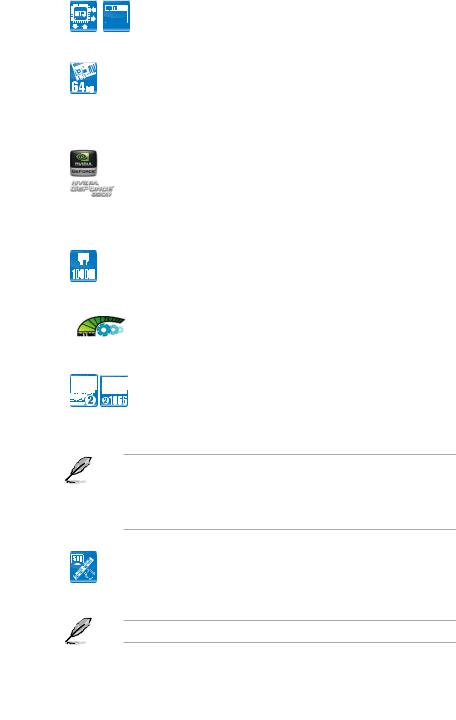
5200
MT/s
HyperTransport™ 3.0 support
HyperTransport™ 3.0 technology provides 2.6 times more bandwidth than HT1.0 that radically improves system efficiency for a smoother, faster computing environment.
64-bit CPU support
64-bit computing, the next generation technology to replace the current
32-bit architecture, delivers advanced system performance, faster memory access, and increased productivity. This motherboard provides excellent compatibility and flexibility by supporting either 64-bit or 32-bit architecture.
NVIDIA® GeForce™ 8200 Chipset
The NVIDIA® GeForce™ 8200 offers the latest support of Hybrid SLI Technology, DirectX10 graphics features, HD video playback with HDMI / DVI output. It also supports HyperTransport™ 3.0 interface, PCI Express™ 2.0 bus architecture, SerialATA3Gb/s devices, and is optimized withAMD’s latestAM2+ and multi-core CPUs to provide excellent system performance.
Gigabit LAN solution
The onboard LAN controller is a highly integrated Gb LAN controller.
It is enhanced with anACPI management function to provide efficient power management for advanced operating systems.
AMD Cool ‘n’ Quiet Technology
The motherboard supports the AMD Cool ‘n’ Quiet Technology, which monitors system operation and automatically adjusts CPU voltage and frequency for a cool and quiet operating environment.
Dual channel DDR2 1066 support
This motherboard supports DDR2 1066, which provides faster data transfer rate and more bandwidth to increase memory data transfer rate and computing efficiency. This enhances system performance in
3D graphics and other memory demanding applications.
•DDR2 1066 is supported byAM2+ CPU only. Refer to theASUS website at www.asus.com for the supported CPU models.
•Due toAM2+ CPU limitation, only one DDR2 1066 DIMM is supported per channel. When four DDR2 1066 DIMMs are installed, all DIMMs run at 800MHz frequency by default for system stability.
Hybrid SLI
Hybrid SLI™ technology, based on NVIDIA’s industry-leading SLI technology, delivers multi-GPU benefits when an NVIDIAmotherboard
GPU is combined with an NVIDIA discrete GPU.
Visit the ASUS website at www.asus.com to download the latest Hybrid SLI driver.
1-2 |
ASUS M3N78-AM |

PCI Express 2.0 support
This motherboard supports the latest PCIe 2.0 devices for double speed and bandwidth which enhances system performance.
Serial ATA 3Gb/s technology
The motherboard supports next-generation SATA hard drives based on the new SATA3Gb/s storage specification. The onboard Southbridge chipset allows RAID 0, RAID 1, RAID 0+1, RAID 5, and JBOD configurations for SerialATAdrives.
6-channel High Definition Audio
The onboard 6-channelALC662 High DefinitionAudio CODEC enables high-quality audio that automatically detects peripherals plugged
into the audio I/O jacks.ALC662 also supports the Windows® Vista Premium OS.
USB 2.0 technology
USB 2.0 is the latest connectivity standard for next generation components and peripherals. Backwards compatible with current USB
1.1 peripherals, USB 2.0 delivers transfer speeds up to 40 times faster at 480Mb/s, for easy connectivity and ultra-fast data transfers.
1.3.2Innovative ASUS features
ASUS MyLogo2™
Turn your favorite photos into 256-color boot logos to personalize your system.
ASUS CrashFree BIOS 3
ASUS CrashFree BIOS 3 is an auto-recovery tool that allows you to restore a corrupted BIOS file using the bundled support DVD, floppy disk, or USB disk that contains the BIOS file.
ASUS EZ Flash 2
ASUS EZ Flash 2 is a utility that allows you to update the BIOS without using a bootable floppy disk or a DOS-based utility.
ASUS Q-Fan
ASUS Q-Fan technology intelligently adjusts CPU fan speeds according to system loading to ensure quiet, cool, and efficient operation.
Chapter 1: Product introduction |
1-3 |

Green ASUS
This motherboard and its packaging comply with the European Union’s
Restriction on the use of Hazardous Substances (RoHS). This is in line with the ASUS vision of creating environment-friendly and recyclable products/packaging to safeguard consumers’ health while minimizing the impact on the environment.
C.P.R. (CPU Parameter Recall)
The BIOS C.P.R. feature automatically restores the CPU default settings when the system hangs due to overclocking failure. C.P.R. eliminates the need to open the system chassis and clear the RTC data. Simply shut down and reboot the system, and the BIOS
automatically restores the CPU parameters to their default settings.
1-4 |
ASUS M3N78-AM |
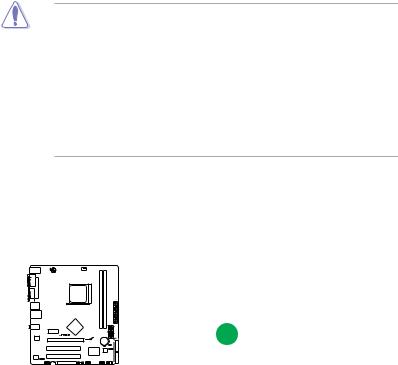
1.4Before you proceed
Take note of the following precautions before you install motherboard components or change any motherboard settings.
• Unplug the power cord from the wall socket before touching any component.
•Before handling components, use a grounded wrist strap or touch a safely grounded object or a metal object, such as the power supply case, to avoid damaging them due to static electricity.
•Hold components by the edges to avoid touching the ICs on them.
•Whenever you uninstall any component, place it on a grounded antistatic pad or in the bag that came with the component.
•Before you install or remove any component, switch off the ATX power supply and detach its power cord. Failure to do so may cause severe damage to the motherboard, peripherals, or components.
Onboard LED
The motherboard comes with a standby power LED that lights up to indicate that the system is ON, in sleep mode, or in soft-off mode. This is a reminder that you should shut down
the system and unplug the power cable before removing or plugging in any motherboard component. The illustration below shows the location of the onboard LED.
SB_PWR
M3N78-AM
ON OFF
Standy Power Powered Off
M3N78-AM Onboard LED
Chapter 1: Product introduction |
1-5 |
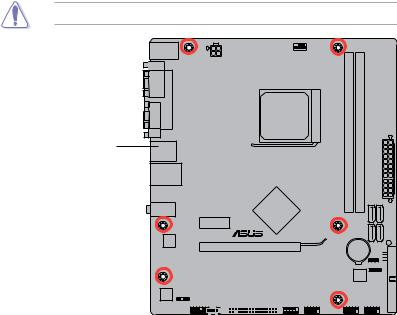
1.5Motherboard overview
1.5.1Placement direction
When installing the motherboard, ensure that you place it into the chassis in the correct orientation. The edge with external ports goes to the rear part of the chassis as indicated in the image below.
1.5.2Screw holes
Place eight screws into the holes indicated by circles to secure the motherboard to the chassis.
Do not overtighten the screws! Doing so can damage the motherboard.
Place this side towards |
the rear of the chassis. |
M3N78-AM
|
|
|
|
|
|
|
|
|
|
|
|
|
|
|
|
|
|
|
|
|
|
|
|
|
|
|
|
|
|
|
|
|
|
|
|
|
|
|
|
|
|
|
|
|
|
|
|
|
|
|
|
|
|
|
|
|
|
|
|
|
|
|
|
|
|
|
|
|
|
|
|
|
|
|
|
|
|
|
|
|
|
|
|
|
|
|
|
|
|
|
|
|
|
|
|
|
|
|
|
|
|
|
|
|
|
|
|
|
|
|
|
|
|
|
|
|
|
|
|
|
|
|
|
|
|
|
|
|
|
|
|
|
|
|
|
|
|
|
|
|
|
|
|
|
|
|
|
|
|
|
|
|
|
|
|
|
|
|
|
|
|
|
|
|
|
|
|
|
|
|
|
|
|
|
|
|
|
|
|
|
|
|
|
|
|
|
|
|
|
|
|
|
|
|
|
|
|
|
|
|
|
|
|
|
|
|
|
|
|
|
|
|
|
|
|
|
|
|
|
|
|
|
|
|
|
|
|
|
|
|
|
|
|
|
|
|
|
|
|
|
|
|
|
|
|
|
|
|
|
|
|
|
|
|
|
|
|
|
|
|
|
|
|
|
|
|
|
|
|
|
|
|
|
|
|
|
|
|
|
|
|
|
|
|
|
|
|
|
|
|
|
|
|
1-6 |
|
|
|
|
|
|
|
|
|
|
|
|
|
|
ASUS M3N78-AM |
|||||
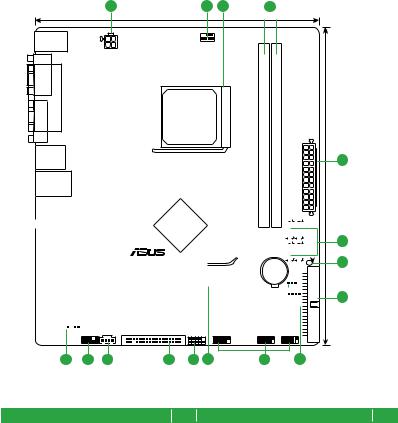
1.5.3Motherboard layout
1 |
2 |
3 |
4 |
|
|
21.8cm(8.6in) |
|
|
|
KB_USB56 |
CPU_FAN |
|
|
|
|
|
ATX12V |
|
|
|
|
COM |
|
|
|
|
|
LPT |
AM2+ |
module) |
module) |
|
|
VGA |
SOCKET |
(64bit, 240-pin |
(64bit, 240-pin |
|
|
USB34 |
|
A1 |
B1 |
|
|
|
DDR2 DIMM |
DDR2 DIMM |
|
24.4cm(9.6in) |
|
LAN1_USB12 |
|
EATXPWR |
1
|
|
AUDIO |
|
|
|
|
NVIDIA® |
|
|
|
|
|
|
|
|
|
|
|
||||
|
|
|
|
GeForce 8200 |
|
|
|
|
|
|
|
|
|
|
|
|||||||
|
|
|
|
|
|
|
|
|
|
|
|
|
SATA4 |
SATA3 |
|
|
|
|
|
|
||
|
|
|
|
|
|
|
|
|
PCIEX1_1 |
|
|
|
|
|
|
|
|
|
|
|
||
|
|
|
|
|
|
|
|
|
|
|
|
|
|
|
SATA2 |
SATA1 |
|
|
|
|
|
|
|
|
|
|
|
|
|
|
|
|
|
|
|
|
|||||||||
|
|
|
|
Realtek |
|
|
|
|
|
|
|
|
|
|
|
|
|
|
|
|||
|
|
|
|
8211CL |
|
|
PCIEX16 |
|
|
|
|
|
|
|
SB_PWR |
|||||||
|
|
|
|
|
|
|
|
|
|
|
|
Lithium Cell |
||||||||||
|
|
|
|
|
|
|
|
|
|
|
|
|||||||||||
|
|
|
|
|
|
|
|
|
|
M3N78-AM |
|
|
CMOS Power |
|||||||||
|
|
|
|
|
|
|
|
|
|
|
|
|
|
|
|
|
CLRTC |
|||||
|
|
|
|
|
|
|
|
|
|
|
|
|
|
|
|
|
|
|
|
|
|
|
|
|
|
|
|
|
|
|
|
|
PCI1 |
|
|
|
|
|
|
SPEAKER |
|||||
|
|
|
|
|
|
|
|
|
|
|
|
|
Super |
|
8Mb |
|
|
|
|
|
|
|
|
|
|
|
|
|
|
|
|
|
|
|
|
|
|
|
|
|
|
||||
|
|
|
|
|
|
|
|
|
|
|
|
|
I/O |
|
BIOS |
|
|
|
|
|
|
|
|
|
|
|
|
|
|
|
|
|
|
|
|
|
|
|
|
|
|
|
|
|
|
|
|
|
|
|
|
|
|
|
|
|
|
|
|
|
|
|
|
|
|
|
|
|
|
|
|
|
ALC |
|
|
|
|
|
PCI2 |
|
|
|
|
|
|
|
|
|
|
|
|
|
|
|
662 |
|
|
|
|
|
|
|
|
|
|
|
|
|
|
|
|
|
|
|
|
|
|
|
|
SPDIF_OUT |
CD |
FLOPPY F_PANEL |
USB910 |
USB78 USB1112 |
|||||||||||||
|
|
|
|
|
|
|
|
|
||||||||||||||
AAFP |
|
|
|
|
|
|
|
15 |
14 |
13 |
12 |
11 |
10 |
9 |
8 |
1.5.4Layout contents
5
6
PRI_IDE
7
Connectors/Jumpers/Slots |
Page |
Connectors/Jumpers/Slots |
Page |
||
1. |
ATX power connectors |
1-21 |
9. |
USB connectors (10-1 pin USB78, USB910, |
1-23 |
|
(24-pin EATXPWR, 4-pinATX12V) |
|
|
USB1112) |
|
2. |
CPU fan connector (4-pin CPU_FAN) |
1-9 |
10. |
Clear RTC RAM (CLRTC) |
1-17 |
3. |
AM2/AM2+ CPU socket |
1-8 |
11. |
System panel connector (10-1 pin F_PANEL) |
1-22 |
4. |
DDR2 DIMM slots |
1-11 |
12. |
Floppy disk drive connector (34-1 pin |
1-20 |
|
|
|
|
FLOPPY) |
|
5. |
Serial ATA connectors (7-pin SATA1-6) |
1-11 |
13. |
Optical drive audio connector (4-pin CD) |
1-21 |
6. |
Onboard LED |
1-5 |
14. |
Front panel audio connector (10-1 pinAAFP) |
1-23 |
7. |
IDE connector (40-1 pin PRI_IDE) |
1-19 |
15. |
Front panel audio connector (10-1 pinAAFP) |
1-24 |
8. |
Speaker (4-pin SPEAKER) |
1-22 |
|
|
|
Chapter 1: Product introduction |
1-7 |
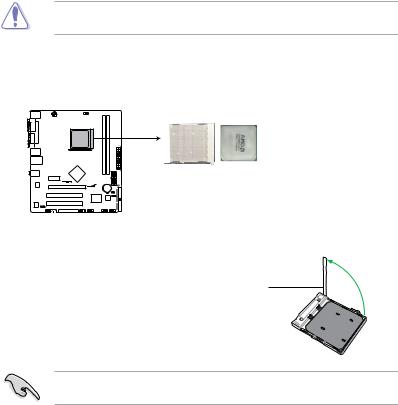
1.6Central Processing Unit (CPU)
The motherboard comes with anAM2+ /AM2 socket designed forAMD® AM2+ /AM2 Phenom™ FX / Phenom /Athlon™ / Sempron™ processor.
TheAM2/AM2+ socket has a different pinout from the 940-pin socket designed for theAMD Opteron™ processor. Use a CPU that is designed for theAM2/AM2+ socket.
1.6.1Installing the CPU
To install a CPU:
1.Locate the CPU socket on the motherboard.
M3N78-AM
M3N78-AM CPU Socket AM2+
2. Press the lever sideways to unlock
the socket, then lift it up to a 90°- Socket lever 100° angle.
Ensure that the socket lever is lifted up to 90°-100° angle, otherwise the CPU will not fit in completely.
1-8 |
ASUS M3N78-AM |
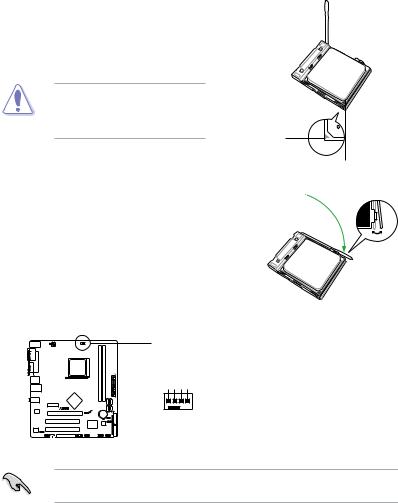
3.Position the CPU above the socket such that the CPU corner with the gold triangle matches the socket corner with a small triangle.
4. Carefully insert the CPU into the socket until it fits in place.
The CPU fits only in one correct orientation. DO NOT force the CPU into the socket to prevent bending the pins and damaging the CPU!
Small triangle
Gold triangle
5.When the CPU is in place, push down the socket lever to secure the CPU. The lever clicks on the side tab to indicate that it is locked.
6. Install a CPU heatsink and fan following the instructions that came with the heatsink package. You can also refer to section 1.6.2 Installing heatsink and fan for instructions.
7.Connect the CPU fan cable to the CPU_FAN connector on the motherboard.
 CPU_FAN
CPU_FAN
CPU FAN PWM
CPU FAN IN
CPU FAN PWR
GND
M3N78-AM
M3N78-AM CPU fan connector
Do not forget to connect the CPU fan connector! Hardware monitoring errors can occur if you fail to plug this connector.
Chapter 1: Product introduction |
1-9 |
